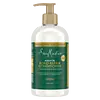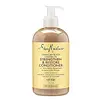What's inside
What's inside
 Key Ingredients
Key Ingredients

No key ingredients
 Benefits
Benefits

 Concerns
Concerns

 Ingredients Side-by-side
Ingredients Side-by-side

Water
Skin ConditioningCetearyl Alcohol
EmollientStearamidopropyl Dimethylamine
EmulsifyingBehentrimonium Chloride
PreservativeCocos Nucifera Oil
MaskingGlycerin
HumectantButyrospermum Parkii Butter
Skin ConditioningEmblica Officinalis Fruit
Skin ConditioningGlutamic Acid
HumectantSerine
MaskingArginine
MaskingHistidine Hcl
Skin ConditioningHelianthus Annuus Seed Oil
EmollientSodium Gluconate
Skin ConditioningSodium Citrate
BufferingCitric Acid
BufferingHydroxypropylgluconamide
HumectantHydroxypropylammonium Gluconate
HumectantDiheptyl Succinate
EmollientCapryloyl Glycerin/Sebacic Acid Copolymer
Skin ConditioningPotassium Sorbate
PreservativeSodium Benzoate
MaskingParfum
MaskingWater, Cetearyl Alcohol, Stearamidopropyl Dimethylamine, Behentrimonium Chloride, Cocos Nucifera Oil, Glycerin, Butyrospermum Parkii Butter, Emblica Officinalis Fruit, Glutamic Acid, Serine, Arginine, Histidine Hcl, Helianthus Annuus Seed Oil, Sodium Gluconate, Sodium Citrate, Citric Acid, Hydroxypropylgluconamide, Hydroxypropylammonium Gluconate, Diheptyl Succinate, Capryloyl Glycerin/Sebacic Acid Copolymer, Potassium Sorbate, Sodium Benzoate, Parfum
Water
Skin ConditioningStearyl Alcohol
EmollientButyrospermum Parkii Butter
Skin ConditioningCocos Nucifera Oil
MaskingCetyl Alcohol
EmollientParfum
MaskingBehentrimonium Chloride
PreservativeGlycerin
HumectantHydroxyethylcellulose
Emulsion StabilisingRicinus Communis Seed Oil
MaskingMacadamia Ternifolia Seed Oil
EmollientAcetic Acid
BufferingSimmondsia Chinensis Seed Oil
EmollientMauritia Flexuosa Fruit Oil
Skin ConditioningHydrolyzed Keratin
HumectantNiacin
SmoothingHydrolyzed Rice Protein
Skin ConditioningTocopherol
AntioxidantGlycine Soja Oil
EmollientHydrolyzed Wheat Protein
Skin ConditioningHydrolyzed Wheat Starch
Skin ConditioningMentha Piperita Leaf Extract
Skin ConditioningTrifolium Pratense Flower Extract
AstringentAloe Barbadensis Leaf Juice
Skin ConditioningPanthenol
Skin ConditioningCaramel
Cosmetic ColorantPropanediol
SolventYeast Extract
Skin ConditioningPolysorbate 60
EmulsifyingDisodium Phosphate
BufferingCaprylhydroxamic Acid
Caprylyl Glycol
EmollientBenzoic Acid
MaskingWater, Stearyl Alcohol, Butyrospermum Parkii Butter, Cocos Nucifera Oil, Cetyl Alcohol, Parfum, Behentrimonium Chloride, Glycerin, Hydroxyethylcellulose, Ricinus Communis Seed Oil, Macadamia Ternifolia Seed Oil, Acetic Acid, Simmondsia Chinensis Seed Oil, Mauritia Flexuosa Fruit Oil, Hydrolyzed Keratin, Niacin, Hydrolyzed Rice Protein, Tocopherol, Glycine Soja Oil, Hydrolyzed Wheat Protein, Hydrolyzed Wheat Starch, Mentha Piperita Leaf Extract, Trifolium Pratense Flower Extract, Aloe Barbadensis Leaf Juice, Panthenol, Caramel, Propanediol, Yeast Extract, Polysorbate 60, Disodium Phosphate, Caprylhydroxamic Acid, Caprylyl Glycol, Benzoic Acid
Ingredients Explained
These ingredients are found in both products.
Ingredients higher up in an ingredient list are typically present in a larger amount.
This ingredient is a preservative and often used for it's anti-static properties. You'll most likely see this ingredient in hair conditioners.
It does not cause irritation or sensitization in leave-on products at 1-5%.
This ingredient is also known as shea butter. It is an effective skin hydrator and emollient.
Emollients help soothe and soften your skin. It does this by creating a protective film on your skin. This barrier helps trap moisture and keeps your skin hydrated. Emollients may be effective at treating dry or itchy skin.
Shea butter is rich in antioxidants. Antioxidants help fight free-radicals, or molecules that may harm the body. It is also full of fatty acids including stearic acid and linoleic acid. These acids help replenish the skin and keep skin moisturized.
While Shea Butter has an SPF rating of about 3-4, it is not a sunscreen replacement.
Shea butter may not be fungal acne safe. We recommend speaking with a professional if you have any concerns.
Learn more about Butyrospermum Parkii ButterCocos Nucifera Oil is obtained from the kernels of the coconut fruit. In other words, this is coconut oil.
Coconut Oil is rich in fatty acids with lauric acid making up the majority of these. It also contains linoleic acid. Due to this high fatty acid content, coconut oil helps trap moisture and soften skin.
Despite being antibacterial, coconut oil may not be great for acne-prone skin. It is comedogenic and may clog pores. This ingredient may not be safe for malassezia or fungal acne.
Note: Coconut Oil should not replace your sunscreen for UV protection. Studies show it only blocks about 20% of UV.
This oil is non-volatile and has a light scent.
The term 'fragrance' is not regulated in many countries. In many cases, it is up to the brand to define this term. For instance, many brands choose to label themselves as "fragrance-free" because they are not using synthetic fragrances. However, their products may still contain ingredients such as essential oils that are considered a fragrance.
Learn more about Cocos Nucifera OilGlycerin is already naturally found in your skin. It helps moisturize and protect your skin.
A study from 2016 found glycerin to be more effective as a humectant than AHAs and hyaluronic acid.
As a humectant, it helps the skin stay hydrated by pulling moisture to your skin. The low molecular weight of glycerin allows it to pull moisture into the deeper layers of your skin.
Hydrated skin improves your skin barrier; Your skin barrier helps protect against irritants and bacteria.
Glycerin has also been found to have antimicrobial and antiviral properties. Due to these properties, glycerin is often used in wound and burn treatments.
In cosmetics, glycerin is usually derived from plants such as soybean or palm. However, it can also be sourced from animals, such as tallow or animal fat.
This ingredient is organic, colorless, odorless, and non-toxic.
Glycerin is the name for this ingredient in American English. British English uses Glycerol/Glycerine.
Learn more about GlycerinParfum is a catch-all term for an ingredient or more that is used to give a scent to products.
Also called "fragrance", this ingredient can be a blend of hundreds of chemicals or plant oils. This means every product with "fragrance" or "parfum" in the ingredients list is a different mixture.
For instance, Habanolide is a proprietary trade name for a specific aroma chemical. When used as a fragrance ingredient in cosmetics, most aroma chemicals fall under the broad labeling category of “FRAGRANCE” or “PARFUM” according to EU and US regulations.
The term 'parfum' or 'fragrance' is not regulated in many countries. In many cases, it is up to the brand to define this term.
For instance, many brands choose to label themselves as "fragrance-free" because they are not using synthetic fragrances. However, their products may still contain ingredients such as essential oils that are considered a fragrance by INCI standards.
One example is Calendula flower extract. Calendula is an essential oil that still imparts a scent or 'fragrance'.
Depending on the blend, the ingredients in the mixture can cause allergies and sensitivities on the skin. Some ingredients that are known EU allergens include linalool and citronellol.
Parfum can also be used to mask or cover an unpleasant scent.
The bottom line is: not all fragrances/parfum/ingredients are created equally. If you are worried about fragrances, we recommend taking a closer look at an ingredient. And of course, we always recommend speaking with a professional.
Learn more about ParfumWater. It's the most common cosmetic ingredient of all. You'll usually see it at the top of ingredient lists, meaning that it makes up the largest part of the product.
So why is it so popular? Water most often acts as a solvent - this means that it helps dissolve other ingredients into the formulation.
You'll also recognize water as that liquid we all need to stay alive. If you see this, drink a glass of water. Stay hydrated!
Learn more about Water